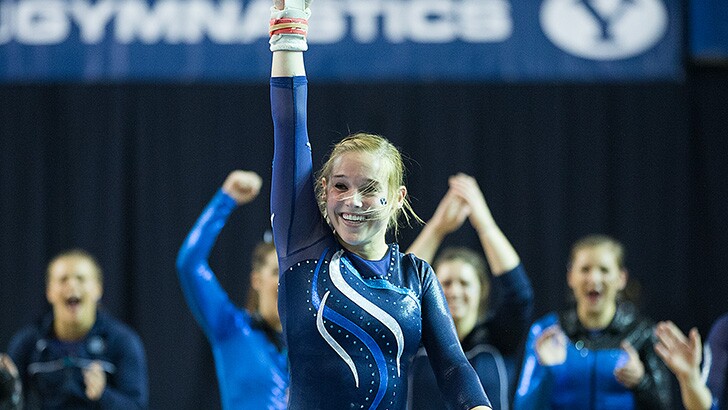
It was the biggest meet of the season. University of Utah fans lined the stands, jeering at the BYU athletes as Megan Bain tried to stay focused on the meet. The first rotation on vault was over, but Bain felt her nerves swell with the pressure of the remaining three events. In the blink of an eye, it was her turn to warm-up. Placing her feet in the corner of the mat, she took off for a double pike, but something was wrong.
'I felt like I punched off of a girl's leg,' Bain said. 'I whipped around to see who got in my way, but no one was there.'
Next moment Bain fell to the ground with a torn Achilles tendon.
Like Bain, many gymnasts are injured every year. According to Elsevier Global Medical News, an average of 4.8 injuries per 1,000 gymnasts occur each year. This may not seem like a large number; however, this annual injury rate rivals that of contact sports such as hockey, soccer and basketball.

Haylee Rollins finishes a routine at the Smith Fieldhouse. Rollins has suffered many injuries during her gymnastics career. (Photo courtesy BYU Athletics)
One reason gymnastics is not perceived as a risk-prone sport is that gymnasts compete through injuries. Olympian Kerri Strug completed a vault during the Atlanta 1996 Summer Olympics on a third-degree sprain. She landed on one foot to capture the gold medal for the United States. Although Brigham Young University athletes do not regularly compete on sprained ankles, these determined athletes have ignored other injuries to compete. BYU Junior Haylee Rollins is another gymnast who ignored her injury to compete.
'My heel started to get a little sore at practice, but I didn't think anything of it,' Rollins said. 'I've always had Seever's. I'm not really one to complain about pain, so I just sucked it up.'
Rollins' heel pain actually indicated a bone spur that shredded her Achilles tendon after she competed on her heel for over a month. Rollins redshirted the 2012 season after the injury prevented her from competing to the fullest.
'We thought it would be about four months of recovery, but I was like, 'That's not going to work for me.' As soon as I could, I started training bars again, although I had to be kind of patient with landings and stuff.'
Rollins made a full recovery at the end of the 2012 season. Just eight months later in October, Rollins suffered the same injury on the other heel. This time, Rollins had surgery immediately. Her hard work and determination paid off, as she was ready to compete on vault just after winter break.
Seeing the trainers was no new experience for Rollins or Bain, as each gymnast receives treatment after meets and practice. Treatments range from being taped with an icepack, to hot baths and massage therapy.
'Every gymnast comes in and gets treatment, where only a couple basketball player come in to the trainers,' Bain said.
Gymnastics training runs the risk of acute injuries, those that occur immediately after an event. Common acute injuries in gymnastics include sprain, lower back injury, Achilles tendon tear and dislocation. Gymnasts also risk chronic injuries similar to those experienced in running or ballet. Rollins has suffered multiple injuries in her gymnastics career.
'I chipped the tip of my heel,' Rollins said. 'I remember doing it, but I didn't think anything of it, so I competed on it for about a month and a half and then found out it was broken. I've torn all kinds of ligaments in my feet, suffered all sorts of bone contusions, broke(n) my ankle, bruised my sternum, (suffered) shin splits, broken ribs and broken fingers.'
Gymnasts are trained to fall correctly in order to prevent injury. Rollins explained falls are a routine part of learning a new skill, so by the time the gymnast has learned the skill, falling isn't a fear. Unfortunately, not all injuries can be prevented through proper falling technique. Gymnasts can get hurt during take-offs and excessive training.
'There is no one that I know (in gymnastics) that hasn't been seriously hurt at some point,' Bain said.
Bain's fall during warm-ups was due to an Achilles tendon tear. Bain miraculously landed the skill after her tendon snapped during take-off.
'The trainers come running over like, 'Stay down, stay down,'' Bain said. 'I thought I was fine because I had to go through my other tumbling passes. The trainers felt my ankle, and my Achilles was just not there. There was just a big gap.'
Bain continued to explain she was stunned when the trainers insisted she was done competing for the entire season. Today, Bain competes for the BYU team but is still recovering from the injury a year later.